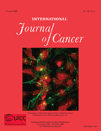IgE, allergy, and risk of glioma: Update from the San Francisco Bay Area Adult Glioma Study in the Temozolomide era
Abstract
The consistently observed inverse relationship of allergic conditions with glioma risk and our previous demonstration that immunoglobulin E (IgE) levels also were lower in glioma patients than controls suggest that atopic allergy may be related to a mechanism that inhibits or prevents glioma. We sought to extend these results with a new and larger series of patients (n = 535 with questionnaire data; 393 with IgE measures) and controls (n = 532 with questionnaire data; 470 with IgE measures). As expected, glioma cases were less likely than controls to report history of allergies [among self-reported cases, Odds ratios (OR) = 0.59, 95% confidence interval (CI): 0.41–0.85]. IgE levels also were lower in glioma cases versus controls (OR per unit log IgE = 0.89, 95% CI (0.82–0.98). However, this inverse relationship was only apparent among cases receiving temozolomide, a treatment which became part of the “standard of care” for glioblastoma patients during the study period. Among patients receiving temozolomide, IgE levels in cases whose blood samples were obtained within 30 days of diagnosis were slightly higher than controls, whereas IgE levels in cases whose blood sample was obtained >60 days after diagnosis were significantly lower than controls (OR = 0.80; 95% CI: 0.71–0.89). Thus, although our results robustly confirm the inverse association between allergy and glioma, the results for IgE are affected by temozolomide treatments which may have influenced IgE levels. These results have implications for the study of immunologic factors in glioma as well as for immunotherapy protocols for treating glioma. © 2009 UICC




